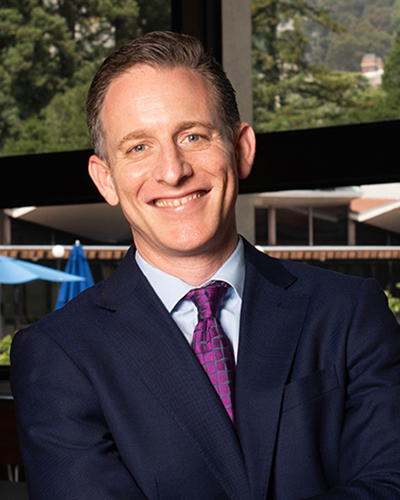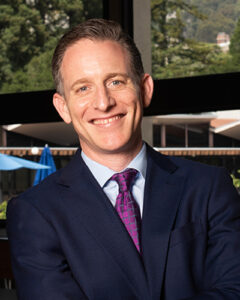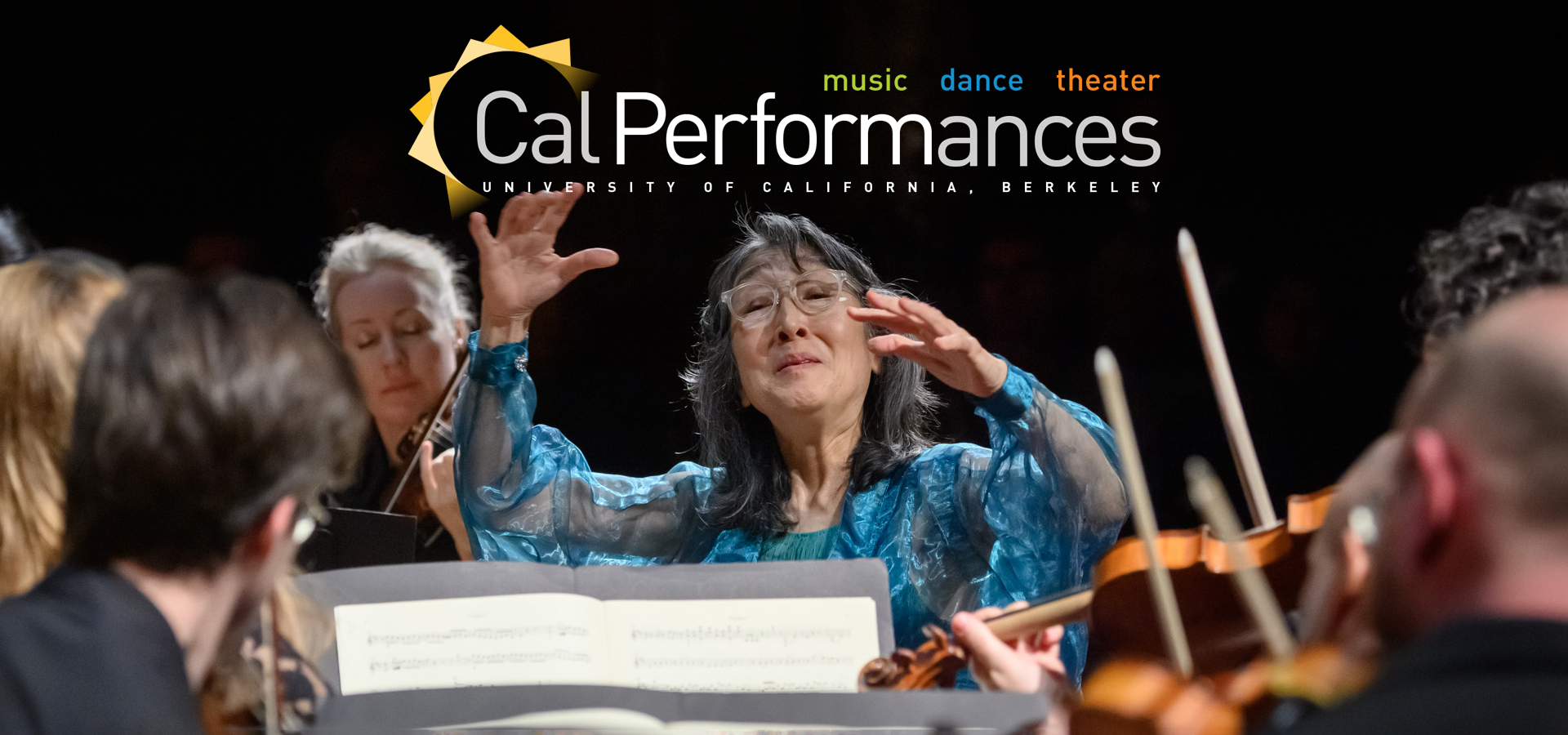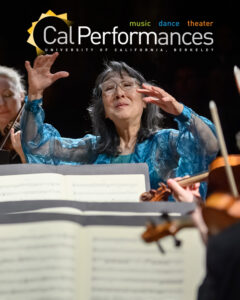Mahler Chamber Orchestra
Mitsuko Uchida, piano and director
José Maria Blumenschein, concertmaster and leader
Sunday, March 24, 2024, 3pm
Zellerbach Hall
Cal Performances is committed to fostering a welcoming, inclusive, and safe environment for all—one that honors our venues as places of respite, openness, and respect. Please see the Community Agreements section on our Policies page for more information.
Run time for this performance is approximately 1 hour 40 minutes including intermission.
From the Executive and Artistic Director

We continue our extraordinary 2023–24 season with a schedule of performances that would be the envy of any performing arts presenter in the nation. I’m especially proud that the legendary pianist Mitsuko Uchida will return to campus this month as Artist in Residence, for two special concerts—March 17 with tenor Mark Padmore in Schubert’s song cycle Winterreise, and March 24 with the acclaimed Mahler Chamber Orchestra in piano concertos by Mozart and an orchestral work by Jörg Widmann—as well as additional opportunities for the campus and wider Bay Area community to engage with her singular artistry. We are also very excited to welcome the return of one of the crown jewels in American dance, The Joffrey Ballet, which this year celebrates the renewal of a multi-season residency at Cal Performances with its first full-length narrative ballet, Anna Karenina, at Zellerbach Hall (Mar 15–17).
The iconic Elevator Repair Service theater company visits from New York with Baldwin and Buckley at Cambridge (Mar 1–3), its lean and elegant production about a historic 1965 debate between the progressive queer Black writer and activist James Baldwin and the “Father of American Conservatism,” William F. Buckley, Jr. And, the Bay Area’s beloved Kronos Quartet celebrates its 50th year of reinventing the string quartet for our global, connected, contemporary world with a special concert featuring a world premiere commissioned from Indonesian composer Peni Candra Rini, who will join the Kronos members onstage as a performer (Mar 2).
We’ll enjoy an artfully curated program by the brilliant young pianist Conrad Tao (Mar 3); the Cal Performances debut of a particularly exciting young string ensemble, the Isidore String Quartet (Mar 5); and the West Coast premiere of Ki moun ou ye (Who are you?), an immersive staged song cycle by composer, flutist, and vocalist Nathalie Joachim (Mar 7). Joachim’s piece is set on the remote Caribbean farmland where her family has lived for generations, and travels deeper into the Haitian heritage introduced on her Grammy-nominated Fanm d’Ayiti recording.
In other genres, the June Award-winning group OKAN demonstrates what can happen when you take a classically trained percussionist from Santiago de Cuba, add a one-time concertmaster from Havana’s Youth Orchestra, and stir in the sounds of Caribbean folkloric and dance music in the context of Toronto’s vibrant immigrant music community (Mar 8); and Wild Up, the dazzling Los Angeles contemporary music collective, reminds us how new a 50-year-old music score can sound with its presentation of Julius Eastman’s ecstatic, jubilant, and hypnotic Femenine. And finally, we can’t wait for the Cal Performances debut of Ema Nikolovska, a young mezzo-soprano on the rise and in demand in international opera houses and concert halls; born in North Macedonia, raised in Toronto, and based in Europe, Nikolovska visits with a program featuring songs by Schubert, Richard Strauss, and Debussy.
Even as all these remarkable performances take place on the UC Berkeley campus, the Cal Performances team is hard at work planning for the mid-April announcement of our 2024–25 season. Trust me when I promise that we have a truly exceptional schedule planned for you, an example of which was last month’s sneak-peak announcement of the Maria Manetti Shrem and Elizabeth Segerstrom California Orchestra Residency, when Cal Performances and the Philharmonic Society of Orange County will bring the world renowned Vienna Philharmonic, conductor Yannick Nézet-Séguin, and pianist Yefim Bronfman to California in March 2025.
Finally, thank you for joining us today at Cal Performances! We’re delighted to spend this time together, celebrating the very best in live music, dance, and theater.
Jeremy Geffen
Executive and Artistic Director, Cal Performances
 We continue our extraordinary 2023–24 season with a schedule of performances that would be the envy of any performing arts presenter in the nation. I’m especially proud that the legendary pianist Mitsuko Uchida will return to campus this month as Artist in Residence, for two special concerts—March 17 with tenor Mark Padmore in Schubert’s song cycle Winterreise, and March 24 with the acclaimed Mahler Chamber Orchestra in piano concertos by Mozart and an orchestral work by Jörg Widmann—as well as additional opportunities for the campus and wider Bay Area community to engage with her singular artistry. We are also very excited to welcome the return of one of the crown jewels in American dance, The Joffrey Ballet, which this year celebrates the renewal of a multi-season residency at Cal Performances with its first full-length narrative ballet, Anna Karenina, at Zellerbach Hall (Mar 15–17).
We continue our extraordinary 2023–24 season with a schedule of performances that would be the envy of any performing arts presenter in the nation. I’m especially proud that the legendary pianist Mitsuko Uchida will return to campus this month as Artist in Residence, for two special concerts—March 17 with tenor Mark Padmore in Schubert’s song cycle Winterreise, and March 24 with the acclaimed Mahler Chamber Orchestra in piano concertos by Mozart and an orchestral work by Jörg Widmann—as well as additional opportunities for the campus and wider Bay Area community to engage with her singular artistry. We are also very excited to welcome the return of one of the crown jewels in American dance, The Joffrey Ballet, which this year celebrates the renewal of a multi-season residency at Cal Performances with its first full-length narrative ballet, Anna Karenina, at Zellerbach Hall (Mar 15–17).
The iconic Elevator Repair Service theater company visits from New York with Baldwin and Buckley at Cambridge (Mar 1–3), its lean and elegant production about a historic 1965 debate between the progressive queer Black writer and activist James Baldwin and the “Father of American Conservatism,” William F. Buckley, Jr. And, the Bay Area’s beloved Kronos Quartet celebrates its 50th year of reinventing the string quartet for our global, connected, contemporary world with a special concert featuring a world premiere commissioned from Indonesian composer Peni Candra Rini, who will join the Kronos members onstage as a performer (Mar 2).
We’ll enjoy an artfully curated program by the brilliant young pianist Conrad Tao (Mar 3); the Cal Performances debut of a particularly exciting young string ensemble, the Isidore String Quartet (Mar 5); and the West Coast premiere of Ki moun ou ye (Who are you?), an immersive staged song cycle by composer, flutist, and vocalist Nathalie Joachim (Mar 7). Joachim’s piece is set on the remote Caribbean farmland where her family has lived for generations, and travels deeper into the Haitian heritage introduced on her Grammy-nominated Fanm d’Ayiti recording.
In other genres, the June Award-winning group OKAN demonstrates what can happen when you take a classically trained percussionist from Santiago de Cuba, add a one-time concertmaster from Havana’s Youth Orchestra, and stir in the sounds of Caribbean folkloric and dance music in the context of Toronto’s vibrant immigrant music community (Mar 8); and Wild Up, the dazzling Los Angeles contemporary music collective, reminds us how new a 50-year-old music score can sound with its presentation of Julius Eastman’s ecstatic, jubilant, and hypnotic Femenine. And finally, we can’t wait for the Cal Performances debut of Ema Nikolovska, a young mezzo-soprano on the rise and in demand in international opera houses and concert halls; born in North Macedonia, raised in Toronto, and based in Europe, Nikolovska visits with a program featuring songs by Schubert, Richard Strauss, and Debussy.
Even as all these remarkable performances take place on the UC Berkeley campus, the Cal Performances team is hard at work planning for the mid-April announcement of our 2024–25 season. Trust me when I promise that we have a truly exceptional schedule planned for you, an example of which was last month’s sneak-peak announcement of the Maria Manetti Shrem and Elizabeth Segerstrom California Orchestra Residency, when Cal Performances and the Philharmonic Society of Orange County will bring the world renowned Vienna Philharmonic, conductor Yannick Nézet-Séguin, and pianist Yefim Bronfman to California in March 2025.
Finally, thank you for joining us today at Cal Performances! We’re delighted to spend this time together, celebrating the very best in live music, dance, and theater.
Jeremy Geffen
Executive and Artistic Director, Cal Performances
About the Program
Wolfgang Amadeus Mozart
Piano Concerto No. 17 in G major, K. 453
Most of Mozart’s piano concertos were written to show off his own keyboard virtuosity, but from time to time he created a concerto for one of his best pupils to
play. The most stunning example of these “gift” concertos is the Piano Concerto in G major, K. 453, composed for Barbara “Babette” Ployer, the talented daughter of a wealthy Salzburg merchant who had moved to Vienna.
The year 1784 was one of spectacular creativity for the composer: in the first three months, he wrote four superb piano concertos, Nos. 14 (also written for Babette Ployer), 15, 16 and 17. The last of these was completed in April 1784 and premiered at a soirée at the Ployer household on June 10, 1784, along with a performance of the Sonata for Two Pianos, K. 448, played by Babette and Mozart
The fact that Mozart needed to make the soloist’s part here a bit easier than those he wrote for himself did not in any way limit the greatness of this concerto. It is a rich and subtle work, characterized by constantly shifting shades of emotional color. And never before had Mozart so successfully integrated orchestra and soloist. He used his modest resources (remember this work was written for home performance) of one flute, two oboes, two bassoons, two horns, and strings plus piano with the utmost beauty, skill, and imagination. And here we have the first example of the composer’s magical writing for woodwinds, which would so characterize his late piano concertos.
The first movement, is not the typical brilliant opener, but something much more complex: an interplay of light and shadow. Touches of pathos and drama will creep in unexpectedly, as will the minor mode in this G major sonata form. The woodwinds tend to provide the harmonic shadows, especially in the development section, which begins with a dialogue between winds playing a five-note ascending and descending motive and the piano following their arc with flowing triplets.
The Andante in C major is perhaps the most remarkable of all three movements. It is an expansive meditation shaped by five appearances (in strings, in piano, in woodwinds, in piano again, finally in woodwinds) of a five-measure theme that, each time, halts abruptly on the dominant. It is a question, seemingly a profound one, in search of an answer. However, the responsive episodes provide none, as the soloist and orchestra probe minor keys and deepen the mystery. Finally, after the woodwinds pose the question in a despairing fashion for the final time, the piano provides the answer—the resolution to the theme—and it is one of perfect simplicity.
The last movement is as witty as any rondo finale Mozart ever wrote, but instead it takes the form of a theme with five variations and a Presto finale. The theme is a perky, two-part bird tune, and indeed Mozart had purchased a pet starling that could sing its opening phrase. (Mozart so loved this starling that when it died in 1787 he buried it with ceremonial rites in his garden and wrote a little poem for its epitaph.) After the five wonderfully contrasted variations finishing with a bold, bravura one for the whole ensemble, the tempo accelerates to Presto for a big wrap-up in the comic-opera spirit of The Marriage of Figaro. The chirpy little theme tries several times to make an appearance, but is laughed off the stage. As Cuthbert Girdlestone writes: “The concerto finishes abruptly, in the highest of spirits, after hacking up beyond all hope of repair the unfortunate theme, the last shreds of which, as the curtain falls, woodwind and piano are merrily throwing to and fro.”
Jörg Widmann
Chorale Quartet, Version for flute, oboe, bassoon, celesta (ad lib.) and string orchestra (US Premiere, 2003/2020)
Born in Munich in 1973, Jörg Widmann is a fine example of a musical polymath. He began his studies with the clarinet and remains today a sought-after orchestral soloist and chamber music partner. But he is also an accomplished pianist, particularly glorying in the music of Schumann, as well as a conductor. As an academic, he has pursued an esteemed career as a professor of both clarinet and composition at the University of Music Freiburg and its Institute for New Music. And, of course, he is a composer, who has been lauded with quantities of prestigious prizes, including the Hindemith Prize, Ernst von Siemens Prize, Arnold Schoenberg Prize, and Stoeger Prize.
Though he has now written many works for large forces—notably the oratorio ARCHE, which had its world premiere in January 2017 at the opening of the spectacular Elbphilharmonie Hall in Hamburg—Widmann stresses that his deepest love is for chamber music. Devoting much of his attention to that category, he has composed eight string quartets, each very different from the others.
The work we’ll hear tonight began life in 2003 as Widmann’s Second String Quartet, the Choralquartett, inspired by Haydn’s late quartet masterpiece The Seven Last Words of Christ. But now we’ll encounter it in new garb: as a work for chamber orchestra (flute, oboe, bassoon, celesta, and string orchestra), commissioned by Carnegie Hall along with the Kozerthaus Dortmund and Kölnmusik in Germany. This version had its world premiere on January 31, 2020 by the Mahler Chamber Orchestra under Mitsuko Uchida’s baton in Pamplona, Spain.
Though Jörg Widmann’s music sounds as contemporary as tomorrow, he says it all emerges from his reverence and total engagement with the great classics of the Austro-German tradition. But as he’s also commented in a recent interview, “Sound itself is so important to me, even before structure. When I begin composing, there is so much of an outburst of emotion, colors, imagination.” The form only follows later. So in the beginning of the Choralquartett, we hear fragments of tonal melody and harmonic progressions, but we soon encounter patches of silence, interspersed with un-pitched noise produced by extended
instrumental techniques. This work is an adventure in sound, both traditional musical sounds and non-traditional, and how it emerges and retreats back into silence. And it is a work of harrowing emotions.
Here is Widmann’s commentary:
My second string quartet consists of a single slow movement. Although the work makes no concrete reference to Joseph Haydn’s Seven Last Words, it would be inconceivable without prior knowledge of this composition. Haydn’s sequence of movements, which (with the exception of the concluding earthquake) are all in slow tempi, still provokes a feeling of shocking urgency in our time. For me, even more disturbing is the calm, composed, and serene acceptance of death in the Haydn work …
In my examination of crucifixion themes, the “path” and the “final journey” were … the essential expressions. My work begins at the end of the path. These are all final tones, phrases from the past, which originated from nowhere and do not lead anywhere. The horrifying friction and abrasion of skin on wood forms a central theme and is associated through silence with tonal choral elements. I am interested in investigating how, through the course of the work, sound effects no longer represent desolation and tonal elements no longer represent confidence.
Mozart
Piano Concerto No. 22 in E-flat major, K. 482
Mozart’s Piano Concerto No. 22 in E-flat major was premiered on December 23, 1785 at a special subscription concert to open Vienna’s 1785–86 winter season. It had been preceded by two of Mozart’s most original and unconventional concertos: K. 466 in D minor and K. 467 in C major. Cuthbert Girdlestone in his guide to the Mozart piano concertos surmises that with this concerto the composer may have consciously returned to a more popular, ingratiating style, lest he get too far ahead of his audience. With its courtly opening flourish and ceremonial trumpets and drums, K. 482’s first movement is in the grand style that his upper-crust audience would have appreciated The beginning of the third movement also sounds like the light-as-air rondo frolic that would have sent his public away happy. But, interestingly, it was the poignant and sublimely beautiful second movement—the most original of the three—that prompted his first audience to demand an encore.
Mozart’s superb writing for the woodwinds plays a crucial supporting role to the piano throughout. For the first time in his concertos, Mozart employed his favorite wind instrument, a pair of clarinets, to replace the customary oboes. Undoubtedly, their fruity, sometimes plaintive tones inspired him to new heights.
The leisurely, expansive first movement opens with a regal flourish and then unfurls a wonderful variety of melodies. And when the piano enters, it hardly bothers with the orchestra’s themes; instead, it has plenty of ideas of its own to introduce and develop, as well as streams of rapid passagework. After a short but dramatic development section, the recapitulation of the opening music is treated with great originality. Now the piano is willing to play the orchestra’s themes, but only on its own ingenious terms.
The crown of this queen of concertos is the magnificent C-minor slow movement: a rueful but not tragic meditation on life’s sorrows. There is pain but also a calm acceptance that suffering is part of humanity’s lot. This is a mood we encounter often in Mozart’s music as he grew older; about this time, he happened to write to his father that he’d come to accept the prospect of death, even an early death, without fear.
With its playful, almost simple-minded theme, the finale suggests it is going to be just another of those lightweight rondo finales that late-18th-century audiences loved. But Mozart has some surprises in store, and the biggest is the interpolation of a slower-tempo minuet interlude midway through the movement. This elegant wind-dominated music returns us partway to the poignant mood of the second movement. And Mozart has yet a final surprise for the concerto’s last moment: a trick ending in which the piano wanders off for one last flight of fancy.
—Janet E. Bedell © 2024
Janet E. Bedell is a program annotator and feature writer who writes for Carnegie Hall, the Metropolitan Opera, Los Angeles Opera, Caramoor Festival of the Arts, and other musical organizations.



